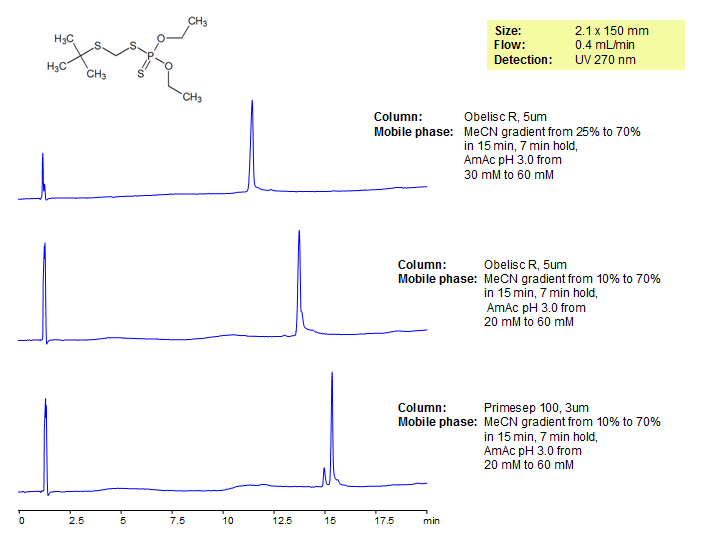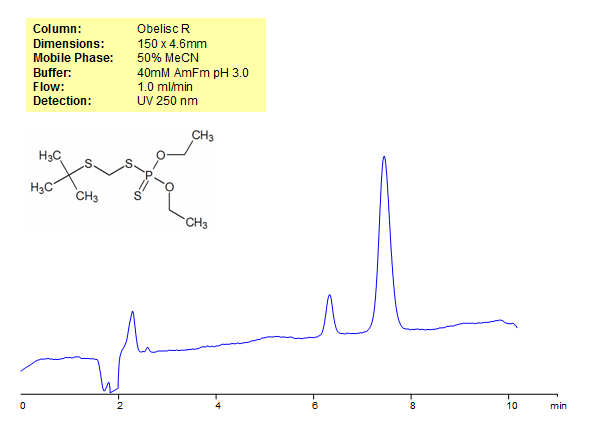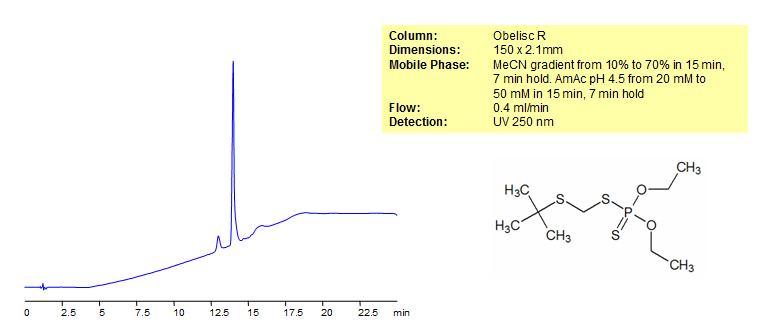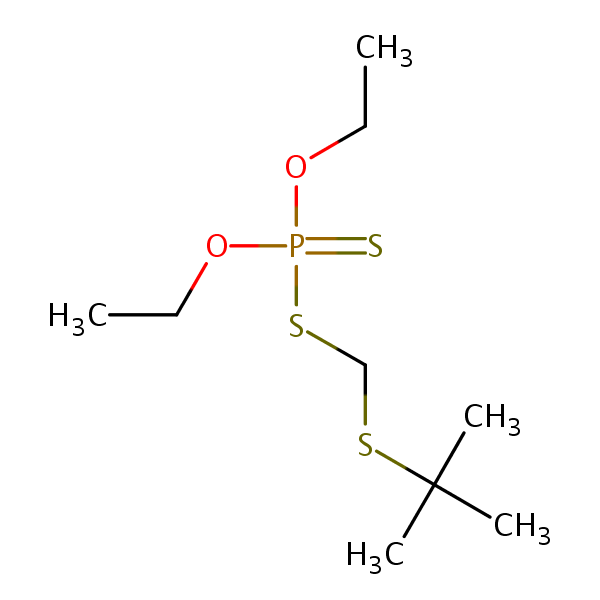| CAS Number | 13071-79-9 |
|---|---|
| Molecular Formula | C9H21O2PS3 |
| Molecular Weight | 288.421 |
| InChI Key | XLNZEKHULJKQBA-UHFFFAOYSA-N |
| LogP | 4.48 |
| Synonyms |
|
Applications:
Terbufos Analysis on Primesep 100 and Obelisc R Columns
September 14, 2015

Terbufos is an organophosphate pesticide and nematocide used in the production of bananas, sugar beets, corn and grain. It is typically applied to the seed or while planting, controlling many insects, wireworms, seedcorn maggots, white grubs, and corn rootworm larva. Terbufos is extremely toxic to workers exposed to concentrated granules. Two mixed-mode HPLC columns were used to separate terbufos with unique selectivity. Primesep 100 is a reverse-phase HPLC column that contains embedded acidic ion-pairing groups. Obelisc R retains compounds with embedded hydrophobic chains and multiple ion-pairing groups. Method can be used to retain and separate dozens of pesticides and is LC/MS compatible.
| Column | Obelisc R, 2.1×150 mm, 5 µm, 100A |
| Mobile Phase | Gradient MeCN – 25-70% |
| Buffer | Gradient AmAc pH 3.0- 30-60 mM |
| Flow Rate | 0.4 ml/min |
| Detection | UV, 270 nm |
| Column | Obelisc R, 2.1×150 mm, 5 µm, 100A |
| Mobile Phase | Gradient MeCN – 10-70% |
| Buffer | Gradient AmAc pH 3.0- 20-60 mM |
| Flow Rate | 0.4 ml/min |
| Detection | UV, 270 nm |
| Column | Primesep 100, 2.1×150 mm, 5 µm, 100A |
| Mobile Phase | Gradient MeCN – 10-70% |
| Buffer | Gradient AmAc pH 3.0- 20-60 mM |
| Flow Rate | 0.4 ml/min |
| Detection | UV, 270 nm |
| Class of Compounds |
Insecticide, Hydrophobic, Ionizable |
| Analyzing Compounds | Terbufos |
Application Column
Obelisc R
SIELC has developed the Obelisc™ columns, which are mixed-mode and utilize Liquid Separation Cell technology (LiSC™). These cost-effective columns are the first of their kind to be commercially available and can replace multiple HPLC columns, including reversed-phase (RP), AQ-type reversed-phase, polar-embedded group RP columns, normal-phase, cation-exchange, anion-exchange, ion-exclusion, and HILIC (Hydrophilic Interaction Liquid Chromatography) columns. By controlling just three orthogonal method parameters - buffer concentration, buffer pH, and organic modifier concentration - users can adjust the column properties with pinpoint precision to separate complex mixtures.
Select optionsPrimesep 100
The Primesep family of mixed-mode columns offers a wide variety of stationary phases, boasting unprecedented selectivity in the separation of a broad array of chemical compounds across multiple applications. Corresponding Primesep guard columns, available with all stationary phases, do not require holders. SIELC provides a method development service available to all customers. Inquire about our specially-tailored custom LC-phases for specific separations.
Select options
Terbufos Analysis on Obelisc R HPLC Column
August 24, 2015

| Column | Obelisc R, 4.6×150 mm, 5 µm, 100A |
| Mobile Phase | MeCN – 50% |
| Buffer | AmFm pH 3.0- 40 mM |
| Flow Rate | 1.0 ml/min |
| Detection | UV, 250 nm |
| Class of Compounds |
Insecticide, Herbicide, Fungicide, Hydrophobic, Ionizable |
| Analyzing Compounds | Terbufos |
Application Column
Obelisc R
SIELC has developed the Obelisc™ columns, which are mixed-mode and utilize Liquid Separation Cell technology (LiSC™). These cost-effective columns are the first of their kind to be commercially available and can replace multiple HPLC columns, including reversed-phase (RP), AQ-type reversed-phase, polar-embedded group RP columns, normal-phase, cation-exchange, anion-exchange, ion-exclusion, and HILIC (Hydrophilic Interaction Liquid Chromatography) columns. By controlling just three orthogonal method parameters - buffer concentration, buffer pH, and organic modifier concentration - users can adjust the column properties with pinpoint precision to separate complex mixtures.
Select options
HPLC Retention of Terbufos on Obelisc N Mixed-Mode Column
August 24, 2015

| Column | Obelisc R, 2.1×150 mm, 5 µm, 100A |
| Mobile Phase | Gradient MeCN – 10-70%, 15 min, 7 min hold |
| Buffer | Gradient AmAc pH 4,5- 20-50 mM, 15 min, 7 min hold |
| Flow Rate | 0.4 ml/min |
| Detection | UV, 250 nm |
| Class of Compounds |
Insecticide, Herbicide, Fungicide, Hydrophobic, Ionizable |
| Analyzing Compounds | Terbufos |
Application Column
Obelisc R
Column Diameter: 2.1 mm
Column Length: 150 mm
Particle Size: 5 µm
Pore Size: 100 A
Column options: dual ended




